1993 CHEVROLET ASTRO PASSENGER parking brake
[x] Cancel search: parking brakePage 57 of 345

Downloaded from www.Manualslib.com manuals search engine Features & Controls
ic
c
Here you can learn about the many standard and optional featur\
es on your
vehicle, and information on starting, shifting and braking. Also\
explained are
the instrument panel and the warning systems that tell you
if everything is
working properly-and what
to do if you have a problem.
For explanation of vehicle symbols, refer to “Vehicle Symbols in
Section
0.
Keys ........................................................................\
............................................... 2-3
Your Doors and How They Work
........................................................................\
2-5
Door
Locks ........................................................................\
.................................. 2-1 0
Theft ........................................................................\
............................................. 2-1 2
New Vehicle “Break-In”
........................................................................\
.............. 2-1 3
Ignition Switch ........................................................................\
............................. 2-1 3
Starting Your Engine ........................................................................\
................... 2-14
Fuel Regulator
........................................................................\
......................... 2-15
Driving Through Deep Standing Water
.......................................................... 2-16
Engine Block Heater
........................................................................\
............... 2-1 6
Automatic Transmission ........................................................................\
.............. 2-1 7
Locking Rear Axle ........................................................................\
....................... 2-20
Parking Brake
........................................................................\
.............................. 2-20
2-1
Page 74 of 345
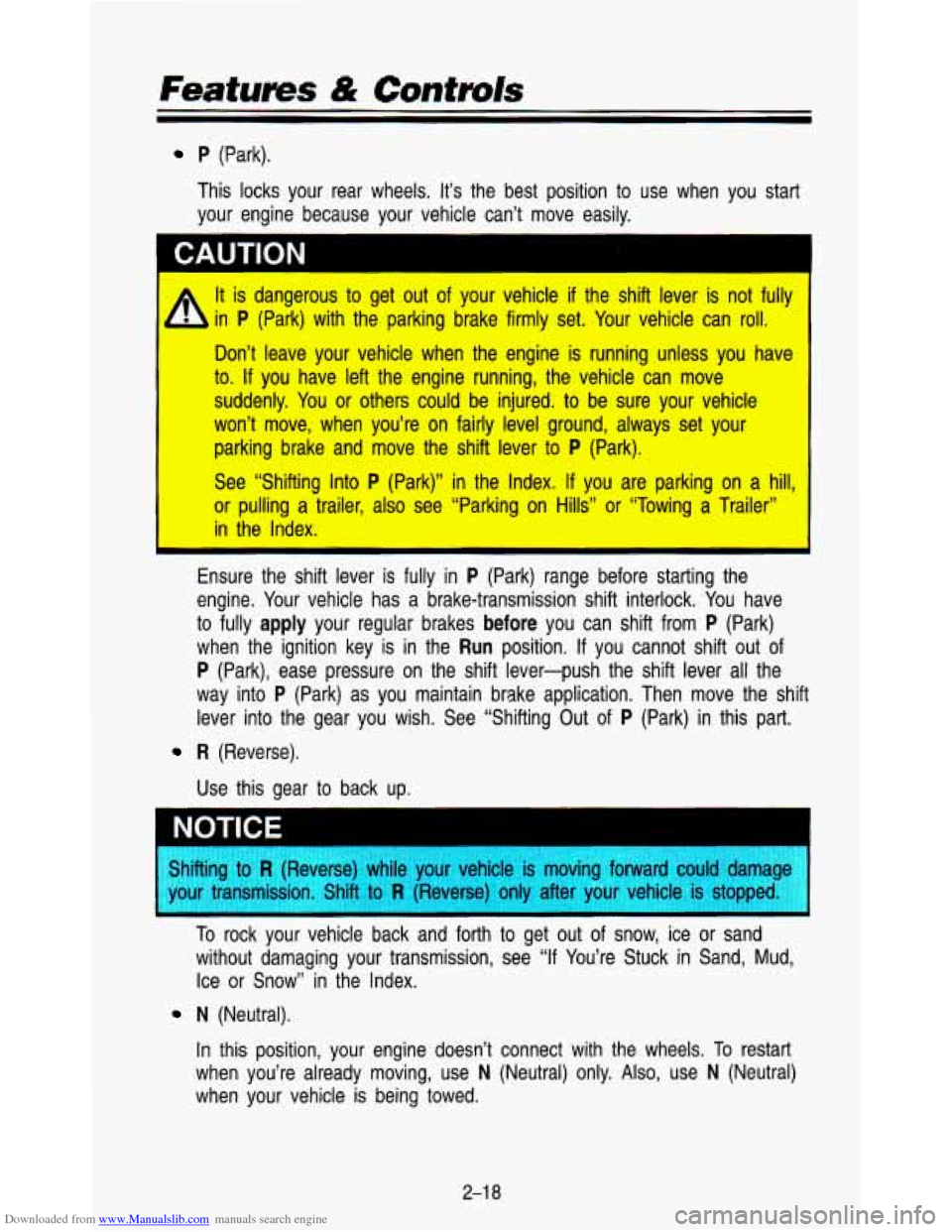
Downloaded from www.Manualslib.com manuals search engine P (Park).
This locks your rear wheels.
It’s the best position to use when you start
your engine because your vehicle can’t move easily.
WTION
It is dangerous to get out of your vehicle if the shift lever is not -fully
in
P (Park) with the parking brake firmly set. Your vehicle can roll. .
Don’t leave your vehicle when the engine is running unless you have
to.
If you have left the engine running, the vehicle can move
suddenly. You
or others could be injured. to be sure your vehicle
won’t move, when you’re on fairly level ground, always set your
parking brake and move the shift lever
to P (Park).
See “Shifting Into
P (Park)” in the Index. If you are parking on a hill:
or pulling a trailer, also see “Parking on Hills” or “Towing a Trailer”
in the Index.
Ensure the shift lever is fully in
P (Park) range before starting the
engine. Your vehicle has a brake-transmission shift interlock. You have
to fully
apply your regular brakes before you can shift from P (Park)
when the ignition key is in the
Run position. If you cannot shift out of
P (Park), ease pressure on the shift lever-push the shift lever\
all the
way into
P (Park) as you maintain brake application. Then move the shift\
lever into the gear you wish. See “Shifting Out of
P (Park) in this part.
R (Reverse).
Use this gear to back up.
I
Shifting to R (Reverse) while your vehicle is moving forward could dama--
your transmission. Shift
to R (Reverse) only after your vehicle is stoppec
To rock your vehicle back and forth to get out of snow, ice or sand
without damaging your transmission, see
“If You’re Stuck in Sand, Mud,
Ice or Snow” in the Index.
N (Neutral).
In this position, your engine doesn’t connect with the wheels.
To restart
when you’re already moving, use
N (Neutral) only. Also, use N (Neutral)
when your vehicle
is being towed.
2-1 8
Page 76 of 345

Downloaded from www.Manualslib.com manuals search engine Features & Controls
mud. If the selector lever is put in 1 (First Gear), the transmission won't
shift into
1 (First Gear) until the vehicle is going slowly enough.
NOTICE 1
I
If your rear wheels can't rotate, don't try to drive. This might happen
you were stuck in very deep sand
or mud or were up against a soli(
obiect. You could damage your transmission or transfar case, or hoth
Atso, IT u stop when goir uphill, m't hold your vel ~ -e tl 'e with only
the accelerator pedal. This could overheat and damage the transmission.
Use yo1 "--kes or shift into :Park) hold your vehicle in position o
Loc&hg Rear Axle
If you have this feature, your rear axle can give you additional traction on
snow, mud, ice, sand or gravel. It works like a standard axle most of the
time,
but when one of the rear wheels has no traction and the other does,
the locking feature will allow the wheel with traction to move\
the vehicle.
Parking Brake
2-20
Page 77 of 345
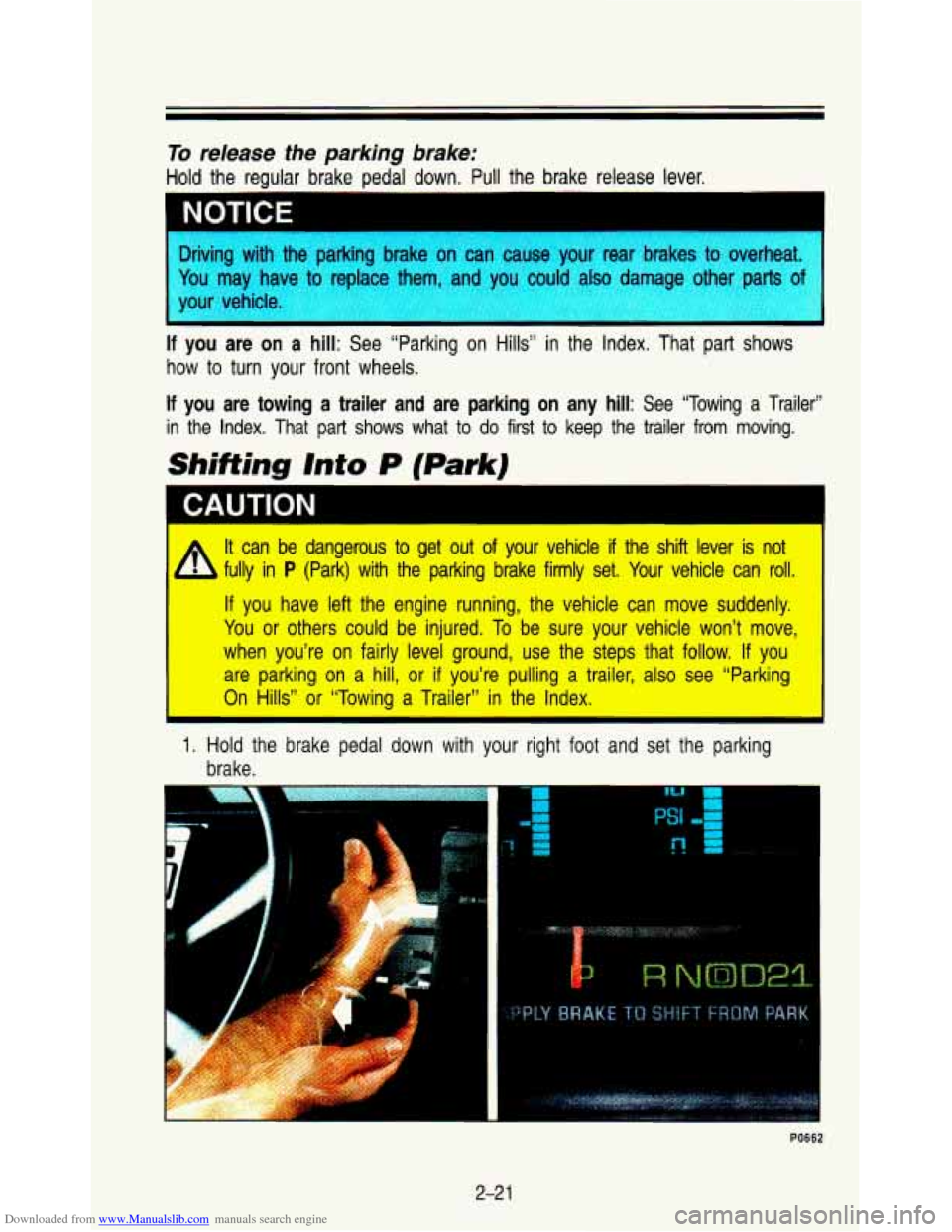
Downloaded from www.Manualslib.com manuals search engine To release the parking brake:
Hold the regular brake pedal down. Pull the brake release lever.
I NOTICE -1
, ,arking brakL
in ronlnro thorn ar
hiving .Ah thc , ,Pwe your real ,rakes to nverheal.
‘ou may ha
‘our vehicle.
- -
If you are on a hill: See “Parking on Hills” in the Index. That part shows
how to turn your front wheels.
If you are towing a trailer and are parking on any hill: See “Towing a Trailer”
in the Index. That part shows what to do first to keep the \
trailer from moving.
Shifting Into P (Park)
A It can be dangerous’to get out of your vehicle if the shift lever is not
b fully in P (Park) with the parking brake firmly set. Your vehicle can roll.
If you have left the-engine running, the vehicle can move suddenly.
You or others
could be injured. To be sure your vehicle won’t-:.rnove,
when you’re on
faiily level ground, use the steps that follow. If you
are parking
on $:hi!!, or if you’re pulling’ a trailer, also see “P;a.rking
On Hills” or “Towing a Trailer” in the Index.
1. Hold the brake pedal down with your right foot and set the parking\
brake.
F“
2-2 1
Page 78 of 345
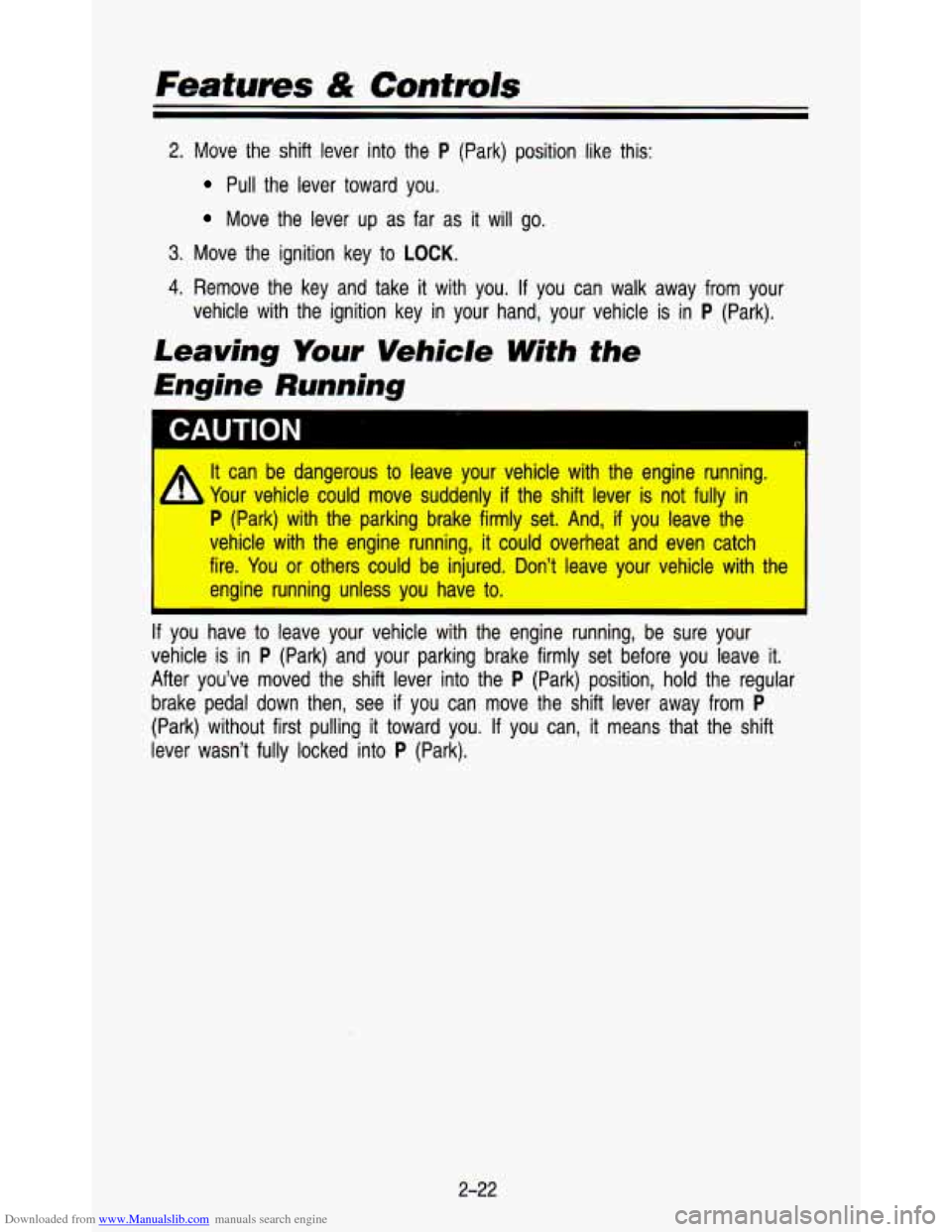
Downloaded from www.Manualslib.com manuals search engine Features & Controls
2. Move the shift lever into the P (Park) position like this:
Pull the lever toward you.
Move the lever up as far as it will go.
3. Move the ignition key to LOCK.
4. Remove the key and take it with you. If you can walk away from your
vehicle with the ignition key in your hand, your vehicle is in
P (Park).
Leaving Your Vehicle With the
Engine Running
It can be dangerous to leave your vehicle with the engine running.
‘) Your vehicle could move suddenly if the shift lever is not fully in
P (Park) with the parking brake firmly set. And, if you leave the
vehicle .with the engine running, it could overheat and even catch’
fire, You or others could be injured. Don’t leave your vehicle with the
I engine running unless you have to.
If you have to leave your vehicle with the engine running, be sure your
vehicle is in
P (Park) and your parking brake firmly set before you leave it\
.
After you’ve moved the shift lever into the
P (Park) position, hold the regular
brake pedal down then, see
if you can move the shift lever away from P
{Park) without first pulling it toward you. If you can, it means that the shift
lever wasn’t fully locked into
P (Park).
2-22
Page 79 of 345
![CHEVROLET ASTRO PASSENGER 1993 1.G Owners Manual Downloaded from www.Manualslib.com manuals search engine Shifting Out of P (park]
Your vehicle has a brake-transmission shift interlock. You have to fully apply
your regular brake before you CHEVROLET ASTRO PASSENGER 1993 1.G Owners Manual Downloaded from www.Manualslib.com manuals search engine Shifting Out of P (park]
Your vehicle has a brake-transmission shift interlock. You have to fully apply
your regular brake before you](/manual-img/24/8011/w960_8011-78.png)
Downloaded from www.Manualslib.com manuals search engine Shifting Out of P (park]
Your vehicle has a brake-transmission shift interlock. You have to fully apply
your regular brake before you can shift from P (Park) when the ignition is in
the
RUN position. See “Automatic Transmission” in the Index.
If you cannot shift out of P (Park), ease pressure on the shift lever-push the
shift lever all the way into
P (Park) as you maintain brake application. Then
move the shift lever into the gear you wish.
If you ever hold the brake pedal down but still can’t shift out of P (Park), try
this:
1. Turn the key to “Off’.
2. Apply and hold the brake until the end of Step 4.
3. Shift to N (Neutral).
4. Start the vehicle and then shift to the drive gear you want.
5. Have the vehicle fixed as soon as you can.
Parking Over Things That Burn
-1
AN22001 2
CAUTION
Things that can burn could touch hot. exhaust parts under your
vehicle and ignite. Don’t park over papers, leaves,
dry grass or other‘
I
I things that- can burn. :-
2-23
Page 81 of 345
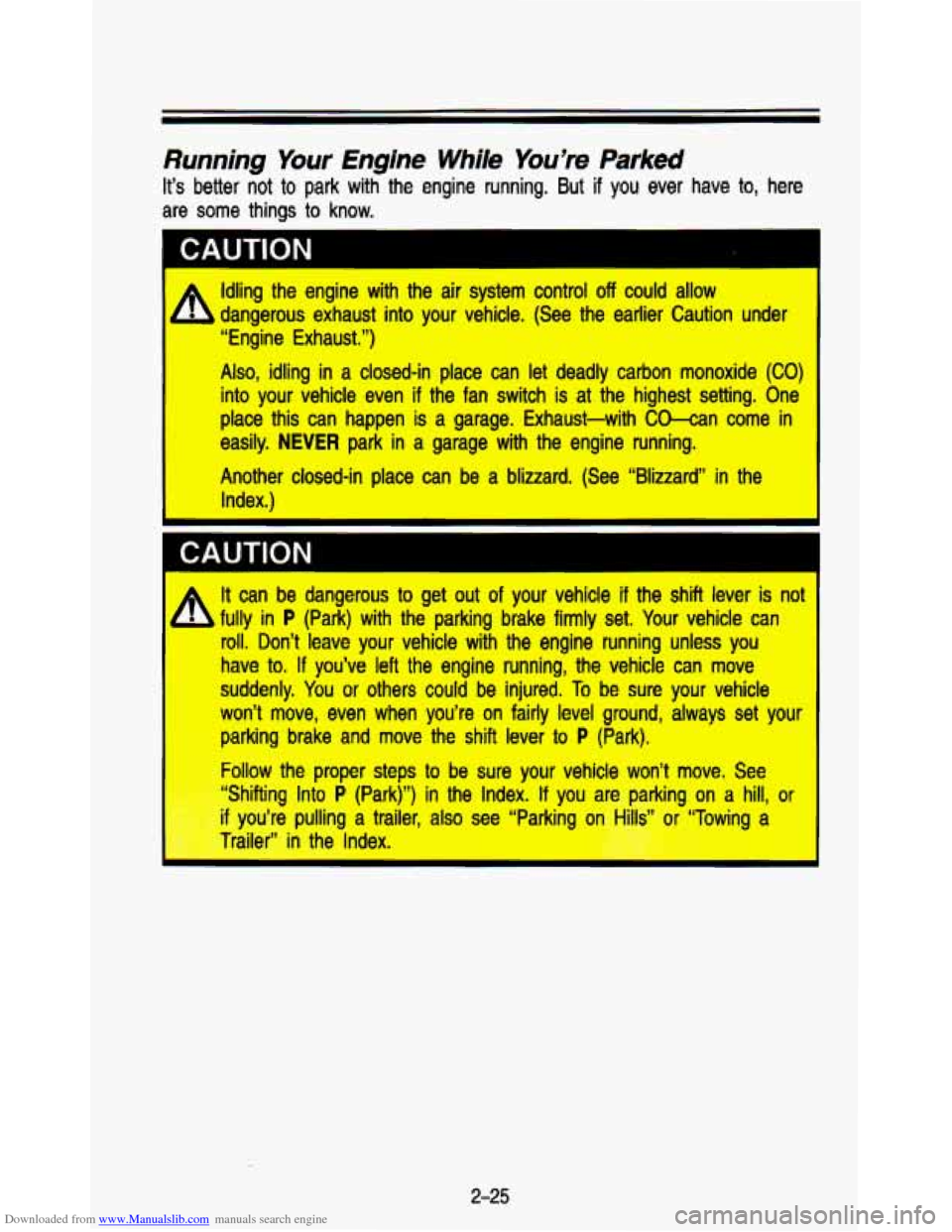
Downloaded from www.Manualslib.com manuals search engine Running Your Engine While You’re Parked
It’s better not to park with the engine running. But if you ever have to, here
are some things to know.
I CAUTION
A
Idling the engine with the air system control off could allow
dangerous exhaust into your vehicle. (See the earlier Caution under
“Engine Exhaust.”)
Also, idling in a closed-in place can let deadly carbon monoxide (CO)
into your vehicle even
if the fan switch is at the highest setting. One
place this can happen is a garage. Exhaust-with Ckan come in
easily.
NEVER park in a garage with the engine running.
Another closed-in place can be a blizzard. (See “Blizzard”\
in the Index.)
I CAUTION
r
A It can be dangerous to get out of your vehicle if the shift lever is not
h fully in P (Park) with the parking brake firmly set. Your vehicle can
roll. Don’t leave your vehicle with the engine running unles\
s you
have to.
If you’ve left the engine running, the vehicle can move
suddenly.
You or others could be injured. To be sure your vehicle
won’t move, even when you’re on fairly level ground, alwa\
ys set your parking brake and move the shift lever to
P (Park).
Follow the proper steps
to be sure your vehicle won’t move. See
“Shifting
Into P (Park)”) in the Index. If you are parking on a hill, or
if you’re pulling a trailer, also see “Parking on Hills” nr “Towing a
Trailer” in the Index.
2-25
Page 99 of 345
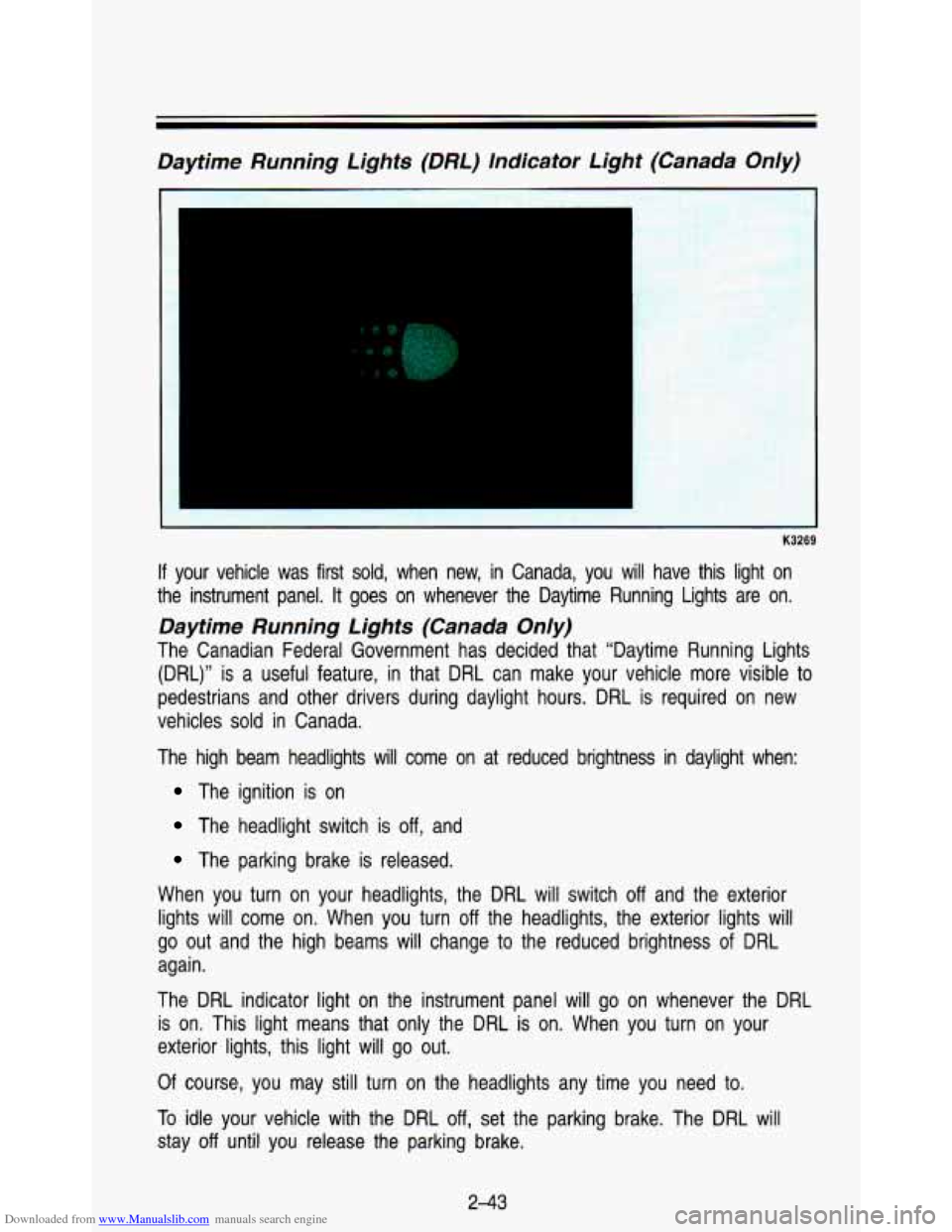
Downloaded from www.Manualslib.com manuals search engine Daytime Running Lights (DM) lndicator Light (Canada Only)
K3269
If your vehicle was first sold, when new, in Canada, you will ha\
ve this light on
the instrument panel. It goes on whenever the Daytime Running Lights are on.
Daytime Running Lights (Canada Only)
The Canadian Federal Government has decided that “Daytime Run\
ning Lights
(DRL)” is a useful feature, in that DRL can make your vehicle more visible to
pedestrians and other drivers during daylight hours. DRL is required on new
vehicles
sold in Canada.
The high beam headlights will come on at reduced brightness in\
daylight when:
The ignition is on
The headlight switch is off, and
The parking brake is released.
When you turn on your headlights, the DRL will switch
off and the exterior
lights will come on. When you turn off the headlights, the exterior lights will
go out and the high beams will change to the reduced brightness of
DRL
again .
The DRL indicator light on the instrument panel will go on wh\
enever the DRL
is on. This light means that only the DRL is on. When you turn on your
exterior lights, this light will go out.
Of course, you may still turn on the headlights any time you need to.
To idle your vehicle with the DRL off, set the parking brake. The DRL will
stay
off until you release the parking brake.
2-43